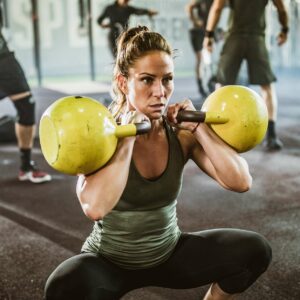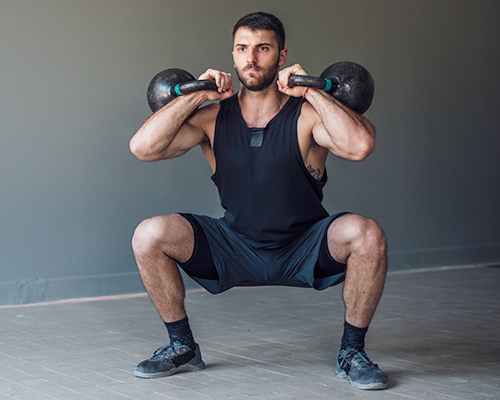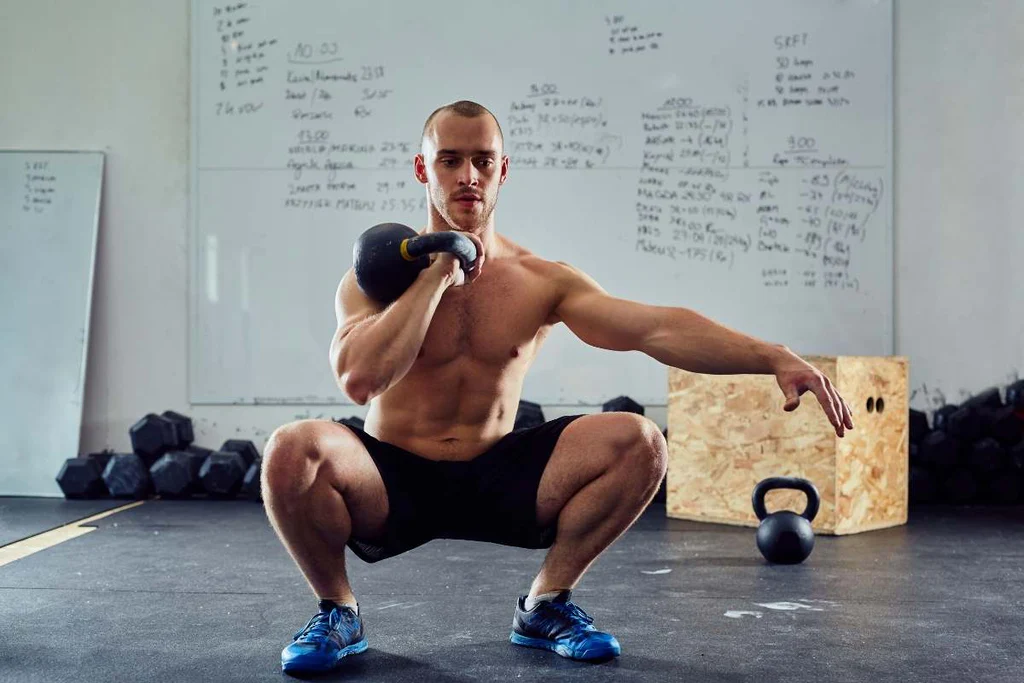KETTLEBELL SQUATS : THE COMPLETE GUIDE
Kettlebell squats are a variation on the traditional squat that uses a kettlebell as an additional load. This is an effective muscle-building exercise for strengthening the legs and buttocks while working on stability and posture.
The kettlebell squat is a kettlebell exercise that offers many advantages for physical preparation. It can improve strength, stability, posture and mobility. The squat is a basic movement that recruits many muscles in the body, including the quadriceps, hamstrings, glutes, calves and abs. In addition, kettlebell squats are an excellent exercise for burning fat and losing weight.
Technique is paramount when performing kettlebell squats to avoid injury. Practitioners need to be aware of their posture, alignment and breathing technique to avoid putting unnecessary strain on their backs. Correct technique must be used to perform the exercise, and it’s important to start with lighter weights and gradually increase to heavier weights to avoid injury.
Kettlebell squats: execution technique
Starting position for the kettlebell squat
- Spread your feet shoulder-width apart, with the tips facing slightly outwards. If you lack flexibility, particularly in ankle flexion, you can take a slightly more spread position.
- Grab the kettlebell with both hands by the sides of the handle and bring it up to your chest, keeping your elbows close to your body.
- Keep your back straight and your eyes forward.
Kettlebell squat movement
- Keeping your chest up and your weight on the entire arch of your foot (don’t take off your heels), begin to squat by bending your knees and hips.
- Lower slowly, until your thighs are parallel to the ground if you lack flexibility, or in full flexion if you are able (the ischios are in contact with the calves).
- Keep your elbows close to your body to keep them well sheathed and compact, and avoid placing unnecessary strain on your shoulders and back.
- Breathe in on the way down and out on the way up.
End position of the kettlebell squat
- Push up with your legs to the starting position.
- Contract your glutes at the top of the movement.
- Repeat the movement as many times as necessary to complete your set.
It is important to maintain proper technique throughout the exercise. Avoid tilting the weight forwards, which would reflect a lack of abdominal and thoracic sheathing. If you can’t keep your torso upright, you’re probably using too much weight for your abilities. Keep your feet firmly planted on the ground and use your leg and buttock muscles to lift the weight.

Kettlebell squats variations
There are different variations of the kettlebell squat that you can use to vary your training and according to your goals. Here are some of them:
Kettlebell front squat
The single kettlebell front squat is a popular variant of the kettlebell squat. It’s performed with one hand and the kettlebell in rack position (resting on the shoulder and forearm).
- Grab a kettlebell with one hand and place it in the rack position.
- Lower yourself into a squat position, keeping your chest high and extending your free arm slightly to the side to maintain good balance.
- Push up with your legs to the starting position.
Double kettlebell front squat
The double kettlebell front squat is the equivalent of the single kettlebell front squat, but with a kettlebell in each hand (in a rack position).
- To get into the starting position, i.e. the rack position, you need to perform a double kettlebell clean.
- From this position, lower yourself into a squat position, keeping your chest up and your elbows slightly tucked in.
- Push up with your legs to the starting position.
This variation of the kettlebell squat is the one that allows you to use the most weight. It is therefore to be preferred when you have a good level to gain strength.
Kettlebell overhead squat
The kettlebell overhead squat is a variation of the kettlebell squat that focuses on the shoulder and upper back muscles. This is an advanced exercise that requires great thoracic mobility and shoulder flexion. Like the front squat, it can be performed one-handed with a single kettlebell or two-handed with two kettlebells.
- Hold the kettlebell above your head, arm outstretched.
- Lower yourself into a squat position, keeping your chest high and your arm extended above your head.
- The free arm is extended in front of you, slightly to the side to maintain balance.
- Push up with your legs to the starting position.
We insist on the fact that the kettlebell overhead squat, with one or two hands, is a technical exercise that requires assiduous work on the mobility of the shoulders, rib cage, hips and ankles. Once mastered, it has many benefits. This is the king of squats.
Kettlebell sumo squat
The kettlebell sumo squat is a variation of the kettlebell goblet squat that focuses on the inner and outer thigh muscles, as well as the glutes.
- Stand in the same position as for the goblet squat, taking a much wider leg span.
- Lower yourself into a squat position, keeping your chest up and your elbows in.
- Push up with your legs to the starting position.
By using these different variations, you can work different muscle groups and add variety to your workout. It is important to master the basic technique of the kettlebell goblet squat before trying these variations.

Benefits and advantages of kettlebell squats
The kettlebell squat is a versatile exercise that offers many advantages for physical preparation, whether for athletes or fitness enthusiasts. Here are just a few :
Strengthening of legs and buttocks
The kettlebell squat is an excellent exercise for strengthening leg and gluteal muscles. Indeed, it solicits the quadriceps, hamstrings, glutes, adductors and calves. This helps develop a solid and stable foundation for the practice of many other exercises.
Improved stability and posture
The kettlebell squat also helps improve stability and posture. In fact, the exercise calls on the stabilizing muscles of the upper back, as well as the abdominal and lumbar muscles, which are essential for maintaining correct posture on a daily basis. Good posture also helps prevent injury and improve performance.
Development of functional strength
The kettlebell squat is a functional exercise that builds strength in movements similar to those we perform in everyday life, such as getting up from a chair or carrying heavy objects. This can help improve quality of life and the ability to perform daily tasks.
Caloric expenditure and weight loss
The kettlebell squat is also an effective exercise for burning calories and promoting weight loss. Indeed, it solicits many muscles of the body, which increases the energy expenditure and thus the exercise metabolism.
The kettlebell squat is therefore an essential exercise for physical preparation, as it offers numerous benefits for strengthening muscles, improving stability and posture, developing functional strength and promoting weight loss.

Tips for practicing the kettlebell squat
Practicing the kettlebell squat can be beneficial for physical preparation, but it is important to follow certain tips to avoid injury and maximize results. Here are a few tips to keep in mind:
Progressiveness
It is important to train progressively in the kettlebell squat. Start with a light weight and focus on technique, gradually increasing the weight and number of reps over time. Avoid lifting heavy weights too quickly, as this can increase the risk of injury.
Integration into a training program
The kettlebell squat can be integrated into a larger training program to maximize results. It can be combined with other kettlebell exercises for a total-body workout, or incorporated into a strength training program to strengthen legs and glutes.
Training frequency
The frequency of training will depend on your personal goals and fitness level. For beginners, it is recommended to start with 2 to 3 sessions per week, using light weights and focusing on technique. More advanced athletes can increase training frequency by using heavier weights and integrating the kettlebell squat into their regular training program.
The kettlebell squat is therefore an effective exercise for strengthening legs and glutes, improving posture and stability, developing functional strength and promoting weight loss. However, it’s important to follow exercise progression advice, use appropriate safety equipment, integrate exercise into a training program and adhere to the recommended training frequency to maximize results and avoid injury.
Other articles that might interest you:
- Kettlebell swing
- Kettlebell clean
- Kettlebell thruster
- Kettlebell snatch
- Kettlebell press
- Kettlebell deadlift
- Kettlebell clean and jerk

